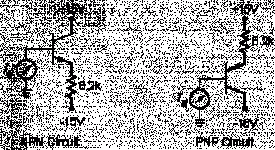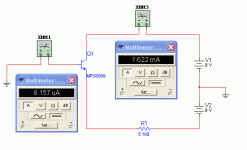Hi Todd,
No. Your uA meter (any current meter) is a low impedance device. Therefore, if it is connected while the junction is forward biased or very leaky, a very high current will flow. This will destroy your uA meter.
Either measure leakage across a very high impedance with a voltmeter (with very high impedance) or simply use a high impedance voltmeter as the detection device. Something 10 Meg or higher.
-Chris
No. Your uA meter (any current meter) is a low impedance device. Therefore, if it is connected while the junction is forward biased or very leaky, a very high current will flow. This will destroy your uA meter.

Either measure leakage across a very high impedance with a voltmeter (with very high impedance) or simply use a high impedance voltmeter as the detection device. Something 10 Meg or higher.
-Chris
Hi Todd,
Now consider installing a defective transistor with a shorted C-B junction, or simply having the polarity switch in the wrong position.
-Chris
Yes it does. (9V - 0.7V) / 4,700 = 1.766 mA, or 1,766 uA. Those meters are usually pretty delicate.Doesn't the emitter resister provide that current limit?
Now consider installing a defective transistor with a shorted C-B junction, or simply having the polarity switch in the wrong position.
-Chris
Thanks Chris. That makes perfect sense. I guess what I don't completely understand is what/why we're measuring/matching this.
What exactly are we measuring with this circuit? B/E Leakage? Is this what affects/causes DC offset voltage?
I guess I don't understand diff-amp basics yet.
..Todd
What exactly are we measuring with this circuit? B/E Leakage? Is this what affects/causes DC offset voltage?
I guess I don't understand diff-amp basics yet.
..Todd
Hi Todd,
To find beta, you want to compare how much base current is used compared to the collector (or emitter) current. The gain is normally high enough so that any error due to measuring the wrong current is less than 1 %. I'd have to look that up. I do believe that it's collector current as the emitter current = base current + collector current.
For leakage across a semiconductor junction, we are assuming a reversed biased junction. So you apply a potential across the junction (could be a diode or J-Fet even) such that you have reverse biased that junction. Then you take a measurement in some manner to maximize your accuracy. These parameters are all temperature dependent as you have seen.
-Chris
To find beta, you want to compare how much base current is used compared to the collector (or emitter) current. The gain is normally high enough so that any error due to measuring the wrong current is less than 1 %. I'd have to look that up. I do believe that it's collector current as the emitter current = base current + collector current.
For leakage across a semiconductor junction, we are assuming a reversed biased junction. So you apply a potential across the junction (could be a diode or J-Fet even) such that you have reverse biased that junction. Then you take a measurement in some manner to maximize your accuracy. These parameters are all temperature dependent as you have seen.
This is one of the things that will affect DC offset voltage in an amplifier. The circuit used and values will also affect the DC offset. Let's just say that if you match everything, you can then calculate the DC offset on paper to a high degree of accuracy. I will do this sometimes in a repair to see if an offset is a fault or design issue. The one thing that does not change is that a matched set of transistors will lower the THD of an amplifier. That's regardless of a DC offset condition.Is this what affects/causes DC offset voltage?
-Chris
Hi Chris,
Okay, sorry if I'm slow or not making my question clear. Here's what I'm getting at.
You said earlier that circuit shouldn't be used forward-biased or we'll blow the uA meter. But to measure current gain we need to forward-bias the transistor, don't we? Yet, this is the circuit Leach provides for that.
So how can it be forward-biased yet only draw 4-20uA?
Leach: "The bias current in each transistor is set at approximately 1.6 mA. Matched transistors will have equal base currents. The expected current should be in the approximate range from 4 uA to 20 uA."
then.. "If you do not have a multimeter that reads microamps, you can put a 51 kohm resistor in series with the base and measure the voltage across the resistor. Matched transistors will have equal voltages. The expected voltages should be in the approximate range of 0.2 V to 1 V."
..Todd
Okay, sorry if I'm slow or not making my question clear. Here's what I'm getting at.
You said earlier that circuit shouldn't be used forward-biased or we'll blow the uA meter. But to measure current gain we need to forward-bias the transistor, don't we? Yet, this is the circuit Leach provides for that.
So how can it be forward-biased yet only draw 4-20uA?
Leach: "The bias current in each transistor is set at approximately 1.6 mA. Matched transistors will have equal base currents. The expected current should be in the approximate range from 4 uA to 20 uA."
then.. "If you do not have a multimeter that reads microamps, you can put a 51 kohm resistor in series with the base and measure the voltage across the resistor. Matched transistors will have equal voltages. The expected voltages should be in the approximate range of 0.2 V to 1 V."
..Todd
Attachments
Hi Todd,
I would tend to want to use a constant current source in the emitter circuit and measure the base current then. At least the numbers would be more reliable. You would calculate beta as (test current) / (measured base current). That should be close enough.
The Heathkit IT-18 works by calibrating the current through the transistor first, then measuring the base limiting resistor resistance (I think). I haven't studied it in a long time.
-Chris
I would tend to want to use a constant current source in the emitter circuit and measure the base current then. At least the numbers would be more reliable. You would calculate beta as (test current) / (measured base current). That should be close enough.
The Heathkit IT-18 works by calibrating the current through the transistor first, then measuring the base limiting resistor resistance (I think). I haven't studied it in a long time.
-Chris
anatech said:Hi Todd,
I would tend to want to use a constant current source in the emitter circuit and measure the base current then. At least the numbers would be more reliable. You would calculate beta as (test current) / (measured base current). That should be close enough.
-Chris
Makes sense to me (for a change).
..Todd
anatech said:Hi Todd,
Before getting into those (you can always simply measure the hFE on each section), check transistors 410,412,414 and 416 for leakage. Often HK will run a transistor close to it's limits both thermally and voltage wise. The result is odd faults. On many HK amps I just replace the lot of transistors with parts having higher ratings.
-Chris
Any recommendations for updated substitutes for these old pre-drivers?
410: 2SC1845
412: 2SA992
414: 2SD666A
416: 2SB646A
..Todd
Well, I was hoping to take your advice and upgrade their power handling (if necessary), Chris.
The problem with Pacific Semi is their $50 minimum order, which is fine for hardcore hobbyists or repair shops. But when you only need a handful of 25 cent parts (and are just learning the basics), it's not practical.
I'll see how it goes after testing/replacing the diff. amp.
..Todd
The problem with Pacific Semi is their $50 minimum order, which is fine for hardcore hobbyists or repair shops. But when you only need a handful of 25 cent parts (and are just learning the basics), it's not practical.
I'll see how it goes after testing/replacing the diff. amp.
..Todd
Hi Todd,
Gee, and I used to complain about a $25 min order at Electrosonic!
You are right though. Most good part sources are not available to someone small just starting out. I went through the same things when I was much younger.
A really good repair shop might have the real parts. There are many fakes out there, so you want a service cente that deals with high end audio. Not TV's and VCRs or car audio. Certainly not a fix-all shop.
-Chris
Gee, and I used to complain about a $25 min order at Electrosonic!
You are right though. Most good part sources are not available to someone small just starting out. I went through the same things when I was much younger.
A really good repair shop might have the real parts. There are many fakes out there, so you want a service cente that deals with high end audio. Not TV's and VCRs or car audio. Certainly not a fix-all shop.
-Chris
- Status
- This old topic is closed. If you want to reopen this topic, contact a moderator using the "Report Post" button.
- Home
- Amplifiers
- Solid State
- Harmon Kardon HK770 amp problem
 Just like magic.
Just like magic. 
